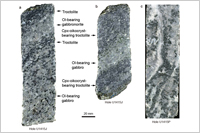Enlarge Image
The first recovery of significant rock sections from fast-spreading lower oceanic crust
Three-quarters of the Earth's oceanic crust formed at fast-spreading ridges is composed of plutonic rocks whose mineral assemblages, textures, and compositions record the history of melt transport and crystallization between the mantle and the seafloor.
Despite the importance of these rocks, sampling them in situ is challenging owing to the overlying upper crust rocks.
The first cored rocks from the lowermost oceanic crust formed at a fast-spreading ridge were recovered at the Hess Deep rift in the equatorial Pacific Ocean during the Integrated Ocean Drilling Program (IODP) Expedition 345. The scientific party of the expedition, including Dr. T. Nozaka (Department of Earth Science, Okayama University), have analyzed and described the recovered rock samples.
The recovered rocks were observed and analyzed using onboard equipment, including optical microscopy, X-ray diffraction, X-ray fluorescence spectrometry, and inductively coupled plasma atomic emission spectrometry.
The dominant plutonic rock types recovered were olivine gabbro and troctolite with primitive chemical compositions. Cumulate texture and modal layering/banding are prevalent, but mineral assemblage and layering/banding structure are highly variable in these rocks. An unexpected finding is orthopyroxene showing evidence of its early crystallization. Geochemical analysis of the primitive plutonic rocks in combination with that of shallow-level rocks provides the most completely constrained estimate of the bulk composition of fast-spreading oceanic crust so far.
The heterogeneity in mineralogy and structure suggest that compositionally diverse melts are extracted from the mantle and partly crystallize before mixing to produce the more homogeneous magmas that erupt. The findings of this study provide a key to understanding the geochemical evolution of the oceanic lithosphere.
Reference:
・Authors: K.M. Gillis et al. (IODP Expedition 345 Scientific Party)
・Title of original paper: Primitive layered gabbros from fast-spreading lower oceanic crust.
・Journal, volume, pages and year: Nature 505, 204-207 (2014).
・Digital Object Identifier (DOI): 10.1038/nature12778
・Journal website: http://www.nature.com/nature/journal/v505/n7482/full/nature12778.html

